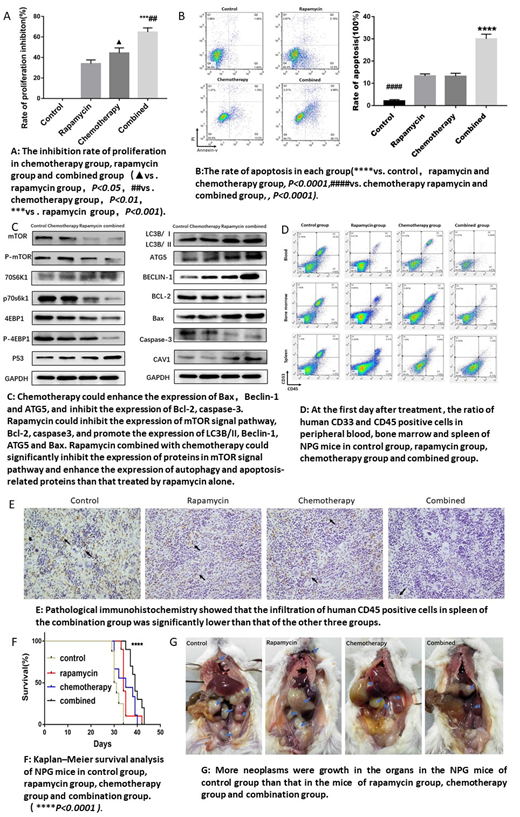Acute myeloid leukemia (AML) is a malignant hematologic disorder. Although current chemotherapy could improve the survival rate of AML patients, some patient would suffer from relapse and had bad therapeutic response. Nowadays, many studies have found that the abnormal expression of mTOR signal pathway is closely related to the occurrence and progression of AML, but the roles of mTOR inhibitor in AML is not elucidated. So, in this paper, we would investigate whether rapamycin, a mTOR inhibitor, could enhance the cytotoxicity of chemotherapy.
Rapamycin or chemotherapy (adriamycin plus cytarabine) could inhibit the proliferation and induce apoptosis of SHI-1 cells (the proliferation inhibition rate and apoptosis ratio were 35.4%±2.94% and 13.33%±0.74% respectively in rapamycin group; Chemotherapy group: 49.9%±4.11%, 13.2%±1.11%). When rapamycin were combined with chemotherapy, the proliferation inhibition rate and apoptosis ratio were significantly increased to 60.3%±3.36% and 30%±1.74% respectively (p<0.05) (Fig.1A, Fig.1B). Western blotting shown that chemotherapy could enhance the expression of Bax, Beclin-1 and ATG5, and inhibit the expression of Bcl-2, caspase-3, nevertheless chemotherapy didn't influence the expression of proteins in the mTOR signal pathway. When mTOR signal pathway were inhibited by rapamycin, the proteins of mTOR signal pathway such as mTOR, p-mTOR, P70S6K1, p-P70S61, 4EBP1, p-4EBP1, and the apoptosis related proteins Bcl-2 and caspase3 of SHI-1 cells were decreased, otherwise, the expression of autophagy-related proteins LC3B/II, Beclin-1, ATG5 and apoptosis-related proteins Bax increased. Rapamycin combined with chemotherapy could significantly inhibit the expression of proteins in mTOR signal pathway and enhance the expression of autophagy and apoptosis-related proteins of SHI-1 cells than that treated by rapamycin alone (Fig.1C).
In order to explore whether mTOR pathway inhibition could enhance the cytotoxicity of chemotherapy in AML animal model. 1×107 SHI-1 cells were inoculated into NPG mice via tail vein to construct systemic leukemia NPG mice. On the 19th day after inoculation, the ratio of human CD45 and 33 double positive cells in peripheral blood of NPG mice was 1.3%, then NPG mice were randomly divided into four groups, control group didn't had treatment, chemotherapy group was treated by adriamycin (1mg/kg) once every other day for three times and cytarabine (100mg/kg) once a day for five days, rapamycin group was treated by rapamycin (10mg/kg) once a day for five days, and combination group was treated by combination chemotherapy and rapamycin. On the first day (24th day)after treatment, the ratio of human CD33 and CD45 double positive cells in peripheral blood, bone marrow and spleen of NPG mice in each treatment group were: control group (20.3%, 23.6%, 15.6%), chemotherapy group (13.6%, 14.1%, 5.50%), rapamycin group (2.03%, 2.68%, 3.31%), combined group (0.308%, 2.49%, 1.10%) (Fig. 1D). The weight of spleen in NPG mice of combination group were significantly lighter than the weight of spleen of NPG mice of other three groups. Pathological immunohistochemistry showed that the infiltration of human CD45 positive cells in spleen of mice in the combination group was significantly lower than that of the other three groups (Fig. 1E). The median survival time of NPG mice in the control group, chemotherapy group, rapamycin group and combination group were 30.5 days, 35.0 days, 34.0 days and 39.0 days, respectively. The survival time of NPG mice in combination group was significantly longer than that in chemotherapy and rapamycin group (P<0.05), while there was no significant difference between chemotherapy group and rapamycin group (P>0.05) (Fig. 1F). When NPG mice were dead, more neoplasms were found in the NPG mice in control group, the treatment of rapamycin or chemotherapy could significantly decrease the degree of extramedullary infiltration of SHI-1 cells in NPG mice, and fewer neoplasms were found in the NPG mice of combination group(Fig.1G).
In conclusion, our studies verified that mTOR signal pathway inhibition by rapamycin could enhance the cytotoxicity of chemotherapy via inhibiting mTOR signal pathway, promoting cell autophagy and inducing apoptosis. mTOR signal pathway may be a potential target for the treatment of AML.
No relevant conflicts of interest to declare.
Author notes
Asterisk with author names denotes non-ASH members.


This feature is available to Subscribers Only
Sign In or Create an Account Close Modal